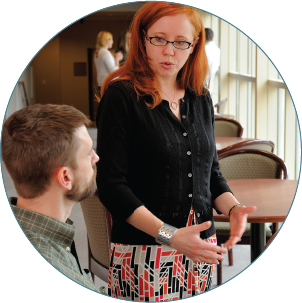Using a Redevelopment Area to Attract Private Investment
Published for Community and Economic Development (CED) on November 20, 2012.
 The neighborhood of Doherty Heights has seen better days. Once a vibrant residential neighborhood that was home to families and retail businesses close to the downtown core, Doherty Heights is now better known for its vacant storefronts and dilapidated houses. The majority of the city’s housing code complaints come from Doherty Heights. Police have identified Doherty Heights as an area of concern. To make matters worse, the neighborhood lies along Main Street, so every visitor to the city gets to see the blighted housing stock and commercial buildings first-hand. As part of a larger effort to revitalize Doherty Heights, city officials are exploring ways to attract private investment to the community, and they want to know how a redevelopment area can help them achieve their goals. The School of Government Development Finance Initiative has been working with city officials on various options, and as part of that effort, I was asked to provide the following brief overview of the city's redevelopment authority.
What is a redevelopment area?
A redevelopment area is a geographic area targeted for redevelopment by a local government pursuant to the Urban Redevelopment Law (North Carolina General Statutes (G.S.) Chapter 160A, Article 22). Buildings in the area can be residential, commercial, or both. To be eligible for designation as a redevelopment area, the targeted area must be classified as blighted—meaning the growth of the area is impaired by the presence of dilapidated or obsolete buildings, overcrowding, or other unsafe conditions—or as being in danger of becoming blighted. The local planning commission is responsible for this determination. G.S. 160A-503(16). Once an area is designated as a redevelopment area, special statutory powers may be exercised there to attract private investment.
What body is authorized to exercise the powers granted by the Urban Redevelopment Law in a redevelopment area?
A redevelopment commission must be formed to exercise the powers granted by the Urban Redevelopment Law. G.S. 160A-504 through G.S. 160A-507.1. The governing board of a local government may serve in this role. G.S. 153A-376(b) for counties, G.S. 160A-456(b) for cities. Once a commission is formed, its first order of business is to create a redevelopment plan. G.S. 160A-513. The redevelopment plan must be approved by the local governing board. Until the redevelopment plan is approved, the commission cannot exercise most of its important development powers. G.S. 160A-513(j).
What powers can a redevelopment commission use to attract private investment to a redevelopment area?
Once a redevelopment plan has been approved, the redevelopment commission may exercise extensive powers within its area of operation to undertake redevelopment projects as defined by G.S. 160A-503(19), to include the following:
The neighborhood of Doherty Heights has seen better days. Once a vibrant residential neighborhood that was home to families and retail businesses close to the downtown core, Doherty Heights is now better known for its vacant storefronts and dilapidated houses. The majority of the city’s housing code complaints come from Doherty Heights. Police have identified Doherty Heights as an area of concern. To make matters worse, the neighborhood lies along Main Street, so every visitor to the city gets to see the blighted housing stock and commercial buildings first-hand. As part of a larger effort to revitalize Doherty Heights, city officials are exploring ways to attract private investment to the community, and they want to know how a redevelopment area can help them achieve their goals. The School of Government Development Finance Initiative has been working with city officials on various options, and as part of that effort, I was asked to provide the following brief overview of the city's redevelopment authority.
What is a redevelopment area?
A redevelopment area is a geographic area targeted for redevelopment by a local government pursuant to the Urban Redevelopment Law (North Carolina General Statutes (G.S.) Chapter 160A, Article 22). Buildings in the area can be residential, commercial, or both. To be eligible for designation as a redevelopment area, the targeted area must be classified as blighted—meaning the growth of the area is impaired by the presence of dilapidated or obsolete buildings, overcrowding, or other unsafe conditions—or as being in danger of becoming blighted. The local planning commission is responsible for this determination. G.S. 160A-503(16). Once an area is designated as a redevelopment area, special statutory powers may be exercised there to attract private investment.
What body is authorized to exercise the powers granted by the Urban Redevelopment Law in a redevelopment area?
A redevelopment commission must be formed to exercise the powers granted by the Urban Redevelopment Law. G.S. 160A-504 through G.S. 160A-507.1. The governing board of a local government may serve in this role. G.S. 153A-376(b) for counties, G.S. 160A-456(b) for cities. Once a commission is formed, its first order of business is to create a redevelopment plan. G.S. 160A-513. The redevelopment plan must be approved by the local governing board. Until the redevelopment plan is approved, the commission cannot exercise most of its important development powers. G.S. 160A-513(j).
What powers can a redevelopment commission use to attract private investment to a redevelopment area?
Once a redevelopment plan has been approved, the redevelopment commission may exercise extensive powers within its area of operation to undertake redevelopment projects as defined by G.S. 160A-503(19), to include the following:
- acquisition of property, including by power of eminent domain for blighted parcels;
- clearance of areas by demolition, removal of existing buildings;
- installation or construction of site improvements and other site preparation;
- entering into contracts for construction, demolition, moving of structures, and repair work (G.S. 160A-514(b) and Article 8 of G.S. Chapter 143).
- sale of real property through competitive bidding procedures (G.S. 160A-514(c));
- carrying out programs of compulsory repair and rehabilitation (probably through the use of minimum housing codes), to include "the making of loans therefor";
- engaging in “programs of assistance and financing, including the making of loans,” for rehabilitation, repair, construction, acquisition, or reconditioning of residential units and commercial and industrial facilities in a redevelopment area. G.S. 160A-512, G.S. 160A-503(19).
- A redevelopment plan for the area must be drafted by the redevelopment commission. North Carolina statutes require the plan to contain certain elements, such as proposed land use changes, a preliminary site plan, and a statement of the estimated cost and the proposed method of financing redevelopment under the plan.
- A public hearing must be held to allow residents to comment on the plan.
- The planning commission may review the plan and certify its recommendation on the plan, either of approval, rejection, or modification with specific changes.
- After receiving the planning commission's recommendation (or upon expiration of the 45 days allotted for review by the planning commission), the redevelopment commission must determine whether to forward the plan to the governing board for approval.
- Upon receipt of the plan from the redevelopment commission, the governing body must hold a public hearing, properly noticed.
- The governing body "shall approve, amend, or reject the redevelopment plan as submitted."
- The Town of Mooresville created a redevelopment area in a historic yet declining neighborhood adjacent to their downtown. The town purchased and rehabilitated derelict properties for first-time homebuyers, used capital funds to improve neighborhood infrastructure, and established a non-profit community development corporation (CDC). See this post.
- The City of Greenville created a redevelopment area in its downtown and focused significant resources there. For example, the city provided assistance to small businesses in the central business district, installed new signage downtown, built a community center, and expanded the library. See this post.
- The City of Sanford designated property around its old railroad depot as a redevelopment area and eventually turned the depot into an urban park and museum. See this post.
Public Officials - Local and State Government Roles
Topics - Local and State Government



